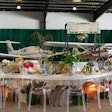1. Get Vendors Talking
Everyone wins when planners work with suppliers who have relationships with one another. "That way you get cross-communication between vendors, so that at the last moment the caterer doesn't approach the lighting designer and say, 'I need to plug in this oven," or three hair dyers, or whatever the last-minute surprise might be," said JKLD's Joe Saint. It may be impossible by then. Good relationships between vendors also help creativity flow. When David Beahm, founder and president of David Beahm Designs, is brought in on a project, he finds he can pull the concept of an event together better when he is aware of what other vendors are doing or have done. "With all the mixed fusion and design cuisine [that's popular] today, it's better if I work with the caterer so that I don't pick dishes or drape tables with linens that obscure or spoil the presentation," he said.
2. Take Notes
"I keep a grid of every V.I.P. in my life, and every time I learn something about them, I put it on the grid," said Marilouise Berdow, senior meeting manager at American Express Corporate Meeting Solutions. Her Excel spreadsheet tells which execs are allergic to feather pillows, what types of rooms they like, what their spouses like to do. ("You want to take care of the spouse even more than the V.I.P.," Danielle Jennings, managing director of Paint the Town Red, said. "If [spouses] are not happy, [V.I.P.s] are not happy.") For sponsors of her events, Elisabeth Kaufman, manager of logistics at Institutional Investor magazine, also keeps track of who executives sit with at dinners and lunches, to make sure they get to interact with different people at each event they attend. (After all, that's part of their reason for being involved with those events in the first place.)
3. Be Smart With Sponsors
When you're looking for companies to sponsor an event, do your homework to find out a potential sponsor's event objectives. "If it's a public company, look at their annual report," said Onute Miller, director of super- and ultrapremium portfolios at Jose Cuervo International. "If it's a private company, start looking at what the brand has been doing. Go to their Web site, Google, find out what kinds of events they do. You'll start to see a theme." Does most of the company's sponsorship money goes toward nonprofit, celebrity, sports, or other types of events? Also, look at where your target company advertises, said Chad Thompson of MVP Group: "That will tell you a lot about their brand, who their audience is."
4. Include ROI in the Planning
To meet budget concerns when you're planning an event, it's always a good idea to have all the business and ROI questions answered first. "More companies want an event that speaks to an ongoing branding message. To get ahead, planners need to be conscious of the ROI. When you can present a plan that's both innovative and works with the business and marketing side [of the event], then you are more likely to sell your idea," said Jacyln Bernstein, the president and partner of Empire Force Events.
5. File a Report
Mickey Schaefer, president of meeting consulting firm Mickey Schaefer & Associates, suggests completing a standardized post-event report after every assignment that includes details about things like costs, requirements, schedule, attendance, vendors, and facilities. "If you have your team do this on every event," Schaefer said, you can build a complete history for a recurring annual event, and give past years' reports to new vendors to help them understand the nature of the next iteration. As chair of the APEX Commission, an initiative of the Convention Industry Council that is developing a system of industry standard practices and tools, she has helped develop a template for such reports, which is available on the council's Web site. Schaefer also suggests using digital photos in such reports to show what an event's elements looked like. When two of her recent events required complicated registration areas, she realized that showing a photograph of the first event's setup would have helped the vendors at the second event understand more quickly what she needed.
6. Time Your Pitches
When digging for sponsorship dollars, find out when companies plan their sponsorship budgets for the year. "If I've planned my year, even if you have a great idea, it's still not going to happen—my money's gone," said Miller. "We usually keep a small reserve for something that might come up, but try to find out when people plan. Usually it's an annual budget, whether it's the calendar year or the fiscal year."
7. Start From the Beginning
Planners and vendors should work together from the start of the planning process to arrive at the best budget-appropriate solutions. "Constantly check in with vendors before the budgeting process gets too involved so you have an accurate picture of the cost and you don't have to backpedal to get to the right number,"
said Levy Lighting's Ira Levy. "The cost is really about the infrastructure—equipment and crew people—so it's not really effective [for the planner to say] at the last minute, 'We're over budget. Let's take out five lights.'"
8. Keep Creativity Fresh
Keep creativity at a high by challenging your staff. "Events don't get stale," said Jean McFaddin of the McFaddin Event Associates. "Production teams get stale. First of all, surround yourself with the best possible people you can, who complement your own talents and have their own talents and can bring that to the table within your core group. But even within that group, you need to rotate them in their responsibilities. Even the best people in the world, if you leave them to a particular task for too long, they get it down to a system, and the next thing you know they get territorial about that system and don't want to change it. You want people to grow, and be challenged, and be excited about each year. They'll become better production people, and more knowledgeable about what they're doing."
9. Mix It Up With Tables
Jodi Jacobs, a sales executive at Party Rental Ltd., pointed out that when you have a large room for a seated event, those at the back can feel left out or distanced from anything that's going on in the front of the room. "The trend now is that planners and designers are more willing to mix the types of tables they use as well as the heights of those tables," she said.
10. Budget for Blunders
When you're working with V.I.P.s—whether they're chief executives, top clients, celebrities, or government officials—plan to be surprised with unusual requests or blunders. "It's really important to put a budget aside for those unknown things that come up," said Kaufman. In cash terms, this might be a couple thousand dollars. But also remember to allocate staff resources, too. As Berdow pointed out, when something goes wrong, your people often get pulled into serving the V.I.P. to fix the situation.
Posted 10.31.05
Everyone wins when planners work with suppliers who have relationships with one another. "That way you get cross-communication between vendors, so that at the last moment the caterer doesn't approach the lighting designer and say, 'I need to plug in this oven," or three hair dyers, or whatever the last-minute surprise might be," said JKLD's Joe Saint. It may be impossible by then. Good relationships between vendors also help creativity flow. When David Beahm, founder and president of David Beahm Designs, is brought in on a project, he finds he can pull the concept of an event together better when he is aware of what other vendors are doing or have done. "With all the mixed fusion and design cuisine [that's popular] today, it's better if I work with the caterer so that I don't pick dishes or drape tables with linens that obscure or spoil the presentation," he said.
2. Take Notes
"I keep a grid of every V.I.P. in my life, and every time I learn something about them, I put it on the grid," said Marilouise Berdow, senior meeting manager at American Express Corporate Meeting Solutions. Her Excel spreadsheet tells which execs are allergic to feather pillows, what types of rooms they like, what their spouses like to do. ("You want to take care of the spouse even more than the V.I.P.," Danielle Jennings, managing director of Paint the Town Red, said. "If [spouses] are not happy, [V.I.P.s] are not happy.") For sponsors of her events, Elisabeth Kaufman, manager of logistics at Institutional Investor magazine, also keeps track of who executives sit with at dinners and lunches, to make sure they get to interact with different people at each event they attend. (After all, that's part of their reason for being involved with those events in the first place.)
3. Be Smart With Sponsors
When you're looking for companies to sponsor an event, do your homework to find out a potential sponsor's event objectives. "If it's a public company, look at their annual report," said Onute Miller, director of super- and ultrapremium portfolios at Jose Cuervo International. "If it's a private company, start looking at what the brand has been doing. Go to their Web site, Google, find out what kinds of events they do. You'll start to see a theme." Does most of the company's sponsorship money goes toward nonprofit, celebrity, sports, or other types of events? Also, look at where your target company advertises, said Chad Thompson of MVP Group: "That will tell you a lot about their brand, who their audience is."
4. Include ROI in the Planning
To meet budget concerns when you're planning an event, it's always a good idea to have all the business and ROI questions answered first. "More companies want an event that speaks to an ongoing branding message. To get ahead, planners need to be conscious of the ROI. When you can present a plan that's both innovative and works with the business and marketing side [of the event], then you are more likely to sell your idea," said Jacyln Bernstein, the president and partner of Empire Force Events.
5. File a Report
Mickey Schaefer, president of meeting consulting firm Mickey Schaefer & Associates, suggests completing a standardized post-event report after every assignment that includes details about things like costs, requirements, schedule, attendance, vendors, and facilities. "If you have your team do this on every event," Schaefer said, you can build a complete history for a recurring annual event, and give past years' reports to new vendors to help them understand the nature of the next iteration. As chair of the APEX Commission, an initiative of the Convention Industry Council that is developing a system of industry standard practices and tools, she has helped develop a template for such reports, which is available on the council's Web site. Schaefer also suggests using digital photos in such reports to show what an event's elements looked like. When two of her recent events required complicated registration areas, she realized that showing a photograph of the first event's setup would have helped the vendors at the second event understand more quickly what she needed.
6. Time Your Pitches
When digging for sponsorship dollars, find out when companies plan their sponsorship budgets for the year. "If I've planned my year, even if you have a great idea, it's still not going to happen—my money's gone," said Miller. "We usually keep a small reserve for something that might come up, but try to find out when people plan. Usually it's an annual budget, whether it's the calendar year or the fiscal year."
7. Start From the Beginning
Planners and vendors should work together from the start of the planning process to arrive at the best budget-appropriate solutions. "Constantly check in with vendors before the budgeting process gets too involved so you have an accurate picture of the cost and you don't have to backpedal to get to the right number,"
said Levy Lighting's Ira Levy. "The cost is really about the infrastructure—equipment and crew people—so it's not really effective [for the planner to say] at the last minute, 'We're over budget. Let's take out five lights.'"
8. Keep Creativity Fresh
Keep creativity at a high by challenging your staff. "Events don't get stale," said Jean McFaddin of the McFaddin Event Associates. "Production teams get stale. First of all, surround yourself with the best possible people you can, who complement your own talents and have their own talents and can bring that to the table within your core group. But even within that group, you need to rotate them in their responsibilities. Even the best people in the world, if you leave them to a particular task for too long, they get it down to a system, and the next thing you know they get territorial about that system and don't want to change it. You want people to grow, and be challenged, and be excited about each year. They'll become better production people, and more knowledgeable about what they're doing."
9. Mix It Up With Tables
Jodi Jacobs, a sales executive at Party Rental Ltd., pointed out that when you have a large room for a seated event, those at the back can feel left out or distanced from anything that's going on in the front of the room. "The trend now is that planners and designers are more willing to mix the types of tables they use as well as the heights of those tables," she said.
10. Budget for Blunders
When you're working with V.I.P.s—whether they're chief executives, top clients, celebrities, or government officials—plan to be surprised with unusual requests or blunders. "It's really important to put a budget aside for those unknown things that come up," said Kaufman. In cash terms, this might be a couple thousand dollars. But also remember to allocate staff resources, too. As Berdow pointed out, when something goes wrong, your people often get pulled into serving the V.I.P. to fix the situation.
Posted 10.31.05



















